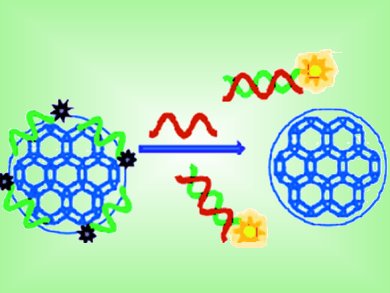Xuping Sun and co-workers, Chinese Academy of Sciences and King Abdulaziz University, Jeddah, Saudi Arabia, report a new application of zeolitic imidazolate framework-8 nanoparticles (ZIFNPs) as an effective sensing platform for the detection of fluorescence-enhanced nucleic acids. The DNA detection is accomplished in two steps:
1) the ZIFNP adsorbs and quenches the dye-labeled single-stranded DNA probe, and
2) subsequent hybridization of the probe with its target produces a double-stranded DNA, which detaches from the ZIFNP, thus resulting in recovery of dye fluorescence (see figure).
These researchers used ZIFNPs as a sensing platform for fluorescence-enhanced detection of an oligonucleotide sequence associated with human immunodeficiency virus (HIV) as their model system. Overall, the method developed is very sensitive, highly selective down to single-base mismatch, and simple. It may have the potential use for universal and effective fluorescence-enhanced detection sensitive and selective to the target molecule studied such as proteins and heavy metal ions.
Image: © Wiley-VCH
- Application of Zeolitic Imidazolate Framework-8 Nanoparticles for the Fluorescence-Enhanced Detection of Nucleic Acids,

S. Liu, L. Wang, J. Tian, Y. Luo, G. Chang, A. M. Asiri, A. O. Al-Youbi, X. Sun,
ChemPlusChem 2011.
DOI: 10.1002/cplu.201100010




